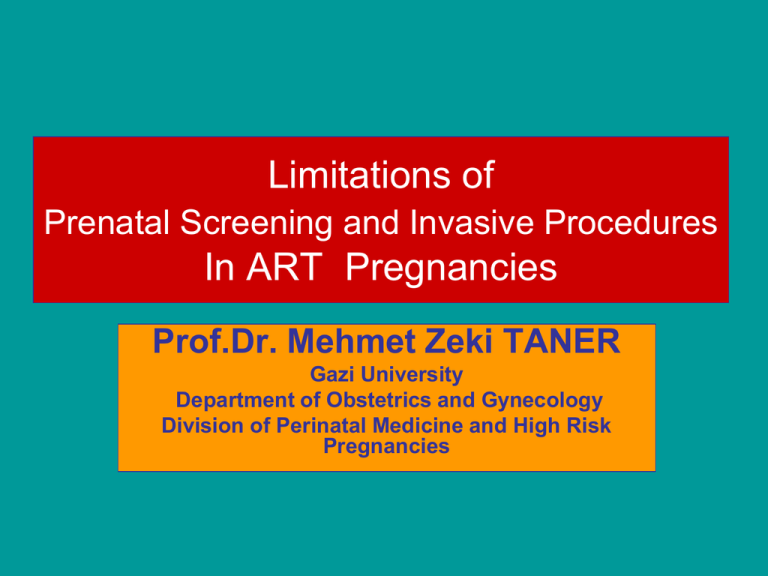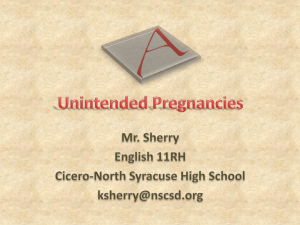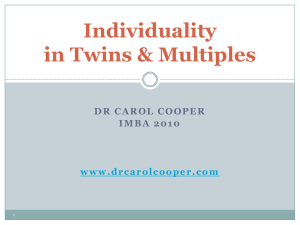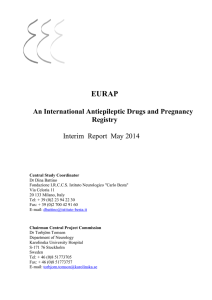
Limitations of
Prenatal Screening and Invasive Procedures
In ART Pregnancies
Prof.Dr. Mehmet Zeki TANER
Gazi University
Department of Obstetrics and Gynecology
Division of Perinatal Medicine and High Risk
Pregnancies
The Main Problems
• Increased background risk
• Altered biochemical parameters even in
singleton
• Increased NT measurement
• Multiple pregnancy
• Zygosity
- The average age of women using ART services in 2005 was 36.
- The group of women using ART services younger than 35,
representing 40% of all ART cycles.
- In the other world the remaning 60% over 35 years old age
group.
Risks of Having Multiple-Fetus Pregnancy and MultipleInfant Live Birth from ART Cycles, 2005
40% Multiple
In Turkey ART report of 3628 live births-2006
– 37.11% were 35 years old
– 36,5% twin or high order multiple
pregnancy
Factors Affecting Biochemical
Parameters
•
•
•
•
•
•
Weight
Smoking
Diabetes
Race
Diet habitus –Vegetarian
Culture media
Orasanu et al 2006
Possible Causes of Adverse Outcomes
Culture Media Formulations
Viable singleton pregnancies at 12 weeks gestation (day 3 ET)
800
600
d
P<0.05
a,c
a
b
400
200
0
P1
N = 281
IVF-500
G1.2
G1.3
81
171
153
Orasanu et al ’06 RBMOnline 12:590-598
Alteration of Biochemical Parameters In
ART Pregnancies:
•
Free and total hCG increased ( multiple corpus luteum, undiagnosed
implantation, vanishing twin, exogenous drugs)
•
PAPP-A, Unconjugated estriol and AFP decreased
Increased FPR
Increased Invasive Procedure
Increased Pregnancy Loss Probability
Psicologic and emotional stress
• Multiple marker screens are particularly
problematic in multiple gestations because
one must rely on a single maternal serum
value to provide information about multiple
fetuses
Serum screening in triplets
• Although second trimester maternal serum
screening for Down syndrome in triplets
has been evaluated in a research setting,
this is not currently used in clinical
practice.
• The criticisms associated with using serum
analytes in twins in the second trimester
also apply to the first trimester.
• It is still uncertain if the combinationof NT
and serum in the first trimester is superior
to using NT only.
Antony O, 2003
Benefits and pitfalls of prenatal screening in a twin pregnancy
A.M. Wray *, H.J. Landy, J.M. MeckInternational Journal of Gynecology
and Obstetrics (2005) 91, 170—171
NT
• In patients with multiples, NT combined with
maternal age appears to be a promising
modality for aneuploidy screening. Because the
NT distribution does not differ significantly in
singletons compared with twins, the Down
syndrome detection rate in multiples is similar to
that in singletons using this modality.
• Conception with ART does not affect the
results, and NT can be performed in triplets and
high-order multiples with similar accuracy as in
singletons.
Zygosity and Aneuploidy Risk
• Determination of zigosity is the first step in
screening of twin pregnancies.
• 1) In monozygotic twins, a single fertilized ovum
splits into two distinct individuals after a variable
number of divisions. These twins are almost always
genetically identical and of the same sex. On
occasion, mutations can cause genetic discordance
resulting in phenotypic and chromosomal
dissimilarities.
• 2)Dizygotic twins result when two separate ova are
fertilized. These individuals are genetically distinct
and most often discordant for chromosomal
anomalies. In dizygotic twins, In other words, the
individual risk estimates for each fetus are summed
to obtain the pregnancy-specific risk.
Meyers et al.,1997
Zygosity and Aneuploidy Risk
• Counseling patients with triplets and high-order multiples
about the risk for aneuploidy is even more complex.
Estimates of pregnancy risk for fetal aneuploidy in
trichorionic pregnancies can be made by multiplying the
singleton risk by the number of fetuses. This technique
assumes that each fetus is genetically distinct.
• Since assisted conception has been associated with
increased rates of monozygosity, and the majority of
triplets and high-order multiples are conceived following
infertility procedures, this method of risk assessment is
really not precise
Jenkins TM, 200
Advanced Maternal Age in Multiple
Pregnancies
• With twin, triplets and high-order multiples,
“advanced maternal age” is thought to be
younger than 35 years.
• In twins AMA is defined as a 31 years old.
• In high order pregnnacies due to small
numbers of patients, charts have not been
created which calculate age-related risks
for fetal aneuploidy in this patient
population
Donor eggs
• Of note, in women who have pregnancies
conceived with donor eggs, the age of the
ovum donor should be used to determine
the pregnancy’s age-related risk for
aneuploidy.
DR and FPR
•
•
Singleton
DR
FPR
– First trimester screen
60-65%
5%
– NT and MA
76.8%
4.2%
–
–
–
–
–
–
87-89%
38%
48%
5%
5%
5%
Combined test
PAPP-A
PAPP-A and MA
Triple test
Quad screen
Integrated test
65%
5%
81%
94%
5%
5%
– First trim screning
– Second trimester
– Quad screen
50%
50%
47%
5%
5%
5%
– NT and MA
88%
9.3%
– First trim combined
79%
9%
Twin
Benefits and pitfalls of prenatal screening in a twin pregnancy
A.M. Wray *, H.J. Landy, J.M. MeckInternational Journal of Gynecology
and Obstetrics (2005) 91, 170—171
Clinical application of nazal bone,tricuspid
flow, ductus venosus, facial angle findings
•
If the risk is more than 1 in 50 and
–
–
–
–
•
•
the risk does not change.
If the risk is 1 in 50 to 1 in 1,000 and the
–
–
–
–
•
tricuspid flow is normal
Nazal bone present
Ductus venosus normal
Facial angle normal
the risk is usually reduced.
–
–
–
–
•
tricuspid flow is normal
Nazal bone present
Ductus venosus normal
Facial angle normal
If there is tricuspid regurgitation
Nazal bone absent
Ductus venosus abnormal
Facial angle wide
the risk is always increased.
CONCLUSION-1
• For singleton the policy is the same as in non-ART
pregnancy
• For multiples: There are many problems.
• Down syndrome risk assessment in multiple gestation
using first- or second-trimester serum analytes is less
accurate than in singleton pregnancies ,
• For twin NT may be used only or combined with serum
analytes in the first trimester followed by second
trimester ultrasonographic survey.
• In the first trimester screening the combined risk
calculation but, not the biochemical risk sholud be used.
• For high order multiple pregnancy the only one choice is
ultrasonographic evaluation
CONCLUSION-2
• Adding NT Nazal bone tricuspid regurtitaion,
Ductus venosus blood flow, and facial angle may
increase the sensitivity and decrase the FPR
• Experience with maternal serum screening in
patients with a multiple gestation during the
second trimester has been limited, and many
centers do not offer this test to these patients.
• Sonographic risk adjustment is important
• At this time, there are no clear standards for
screening for aneuploidy in patients with
multiples.
ACOG Practice Bulletin 2007 How does screening for
aneuploidy differ in multifetal gestations?
• Serum screening tests are not as sensitive in twin or
triplet gestations, in part because data from multiple
gestations that include an aneuploid fetus is so scarce
that expected analyte levels must be estimated by
mathematical modeling.
• In addition, analytes from both the normal and the
affected fetuses enter the maternal serum and are in
effect averaged together, thus masking the abnormal
levels of the affected fetus.
• In monochorionic twin pregnancies, the median nuchal
translucency values are larger in 38% of twin pairs
destined to develop severe twin–twin transfusion
syndrome.
•
ACOG Practice Bulletin 2007 How does screening for
aneuploidy differ in multifetal gestations?
• Furthermore, counseling is more complex because
women must consider a different set of options in the
event that only one of the fetuses is affected. Nuchal
translucency screening in the first trimester with the
option of a CVS and earlier selective reduction may be
desirable for some women.
• Experience is limited with triplet gestations, but studies
suggest that nuchal translucency measurement is
feasible.
• Until further studies are done, however, risk assessment
in multiple gestations should be performed judiciously,
and patients who are at increased risk of aneuploidy
should be counseled regarding diagnostic testing
Invasive Procedure In Multiples
• Invasive screening tests have the
advantage of providing a definitive
diagnosis, but with increased risk to the
pregnancy over non-invasive screening.
Chorionicity
• Knowledge of chorionicity is critical for all
invasive procedures in multiple pregnancies,
and is best established by ultrasound in the first
trimester.
• Before 13 weeks, the correct identification of the
lambda sign (a triangular projection of
echodense placental chorionic villi between two
sacs) can correctly identify dichorionicity in all
twin pregnancies .
Brambati B,et al. 2001
Amniocentesis/CVS in Monochorionic Twins
• Tests for prenatal diagnosis in
monochorionic pregnancies should require
only one sample, as the fetuses should be
chromosomally identical.
• Due to the small but present risk of postzygotic mutations, testing of both fetuses
in a monochorionic pregnancy should be
considered.
Discordant Monochorionic Twins
•
•
•
However, many case reports have described ‘Identical Twins’ with
discordant karyotypes.
The causes of the discordance are varied and include:
– mosaicism,
– skewed X-inactivation,
– differential gene-imprinting and
– small scale mutations (Machin, 1996).
Cases of monozygotic twins with discordant karyotypes include
mosaicism for
– Turner syndrome,
– Down syndrome,
– Patau syndrome,
– trisomy 1 and 22q11 deletion syndrome
(Hausknecht et al., 1981; Rogers et al., 1982; Watson et al., 1990; Kaplowitz et al., 1991; Beattie et al., 1993; Lespinasse et al., 1998; Nieuwint et al., 1999; Schmid et al., 2000; Wachtel et al., 2000).
Amniocentesis in Monochorionic Twins
• The exact prevalence of heterokaryotypic monozygotic
pregnancies is unknown, but it is a rare phenomenon.
• General opinion is,
– if one, or both, of the fetuses has an ultrasound abnormality (or
marker of aneuploidy), both sacs should be sampled, even if the
twins are apparently monochorionic.
• When monochorionicity is certain, neither fetus has an
anatomical abnormality and fetal growth is not severely
discordant, sampling a single amniotic sac is sufficient.
Nieuwint et al., 1999
Detailed Placental Location and Gestational Sac
Description
• A detailed verbal description of placental
locations and gestational sacs should be
included in the procedure note,
• The following is an example of such a description:
– triplet A is located lowermost with a posterior placenta and
was tested with transcervical CVS;
– triplet B is located on the maternal right with an anterior
placenta and was tested with transabdominal CVS/AC;
– triplet C is located on the maternal left with a postero-lateral
placenta and was tested with transabdominal CVS/AC.
•
The relative filling of the bladder should also be
noted.
• Since any woman undergoing genetic
amniocentesis is unfortunately a
potential candidate for fetocide,
incorrect documentation, sampling or
labeling might bring about a disastrous
termination of the wrong fetus (Taylor
and Fisk, 2000).
Chorionic villus sampling
• When more than one placenta is tested,
separate needles are used for each
sampling so as to avoid croscontamination
AMNIOCENTESIS
• Three techniques have been described for
amniocentesis in twins.
– 1)The most common technique is the use of two
different needles. ( Misdiagnosis using such a
technique has been reported and might involve up to
3.5% of samples ,van der Pol et al., 1992; Jenkins
and Wapner, 2000).
– 2)The single needle technique.
– 3) The third technique, even less widely used, is the
insertion of two different needles with simultaneous
ultrasound visualization of both sides of the dividing
membranes
CONCLUSİON
• A detailed description of placental locations and
gestational sacs should be included in the procedure
note,
• In dizygotic pregnancy all fetusus sholud be sampled.
• In monozygotic pregnancies without abnormalities only
one, if abnormalities present or suspected both/all
fetuses should be sampled.










